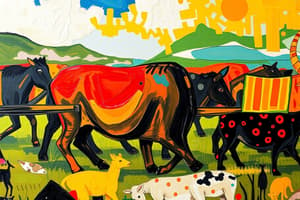Podcast
Questions and Answers
What does the term 'Population' refer to?
What does the term 'Population' refer to?
- A group of organisms of different species living together
- A group of organisms of the same species that lives in the same area (correct)
- The total number of species in a habitat
- A large geographical area inhabited by organisms
What is Population Size?
What is Population Size?
The number of individuals in a population.
Define Population Density.
Define Population Density.
The individuals that make up the population size per unit area or volume.
What is Population Distribution?
What is Population Distribution?
What does a Survivorship Curve represent?
What does a Survivorship Curve represent?
What is Immigration?
What is Immigration?
Define Emigration.
Define Emigration.
What does Dispersal mean in ecology?
What does Dispersal mean in ecology?
What is Migration?
What is Migration?
Define Exponential Growth.
Define Exponential Growth.
What is Logistic Growth?
What is Logistic Growth?
What does Carrying Capacity represent?
What does Carrying Capacity represent?
Define K-Selected Species.
Define K-Selected Species.
What are r-Selected Species?
What are r-Selected Species?
Flashcards are hidden until you start studying
Study Notes
Population Concepts
- Population: A group of organisms of the same species in a specific area.
- Population Size: The total number of individuals within a population.
- Population Density: The concentration of individuals in a population per unit area or volume.
- Population Distribution: The spatial arrangement of individuals within their habitat.
Population Dynamics
- Survivorship Curve: A graph illustrating the number of individuals alive at each age, providing insight into mortality rates at different life stages.
- Immigration: The process where individuals from one population join another population in a different location.
- Emigration: The departure of individuals from a population to reside elsewhere.
- Dispersal: The movement of offspring away from their parents to establish new territories.
- Migration: Seasonal, regular movement of populations or individuals that occurs annually.
Growth Patterns
- Exponential Growth: A growth pattern where the population increases slowly initially, then accelerates as the size expands.
- Logistic Growth: A growth pattern that plateaus as the population approaches its carrying capacity, with growth slowing down significantly.
Carrying Capacity
- Carrying Capacity (K): Denotes the maximum sustainable population size that an ecosystem can support without leading to degradation.
- K-Selected Species: Species that thrive in stable environments, exhibiting population control through density-dependent factors.
- r-Selected Species: Species adapted to unstable environments, characterized by rapid population growth and uncontrolled reproduction.
Studying That Suits You
Use AI to generate personalized quizzes and flashcards to suit your learning preferences.




